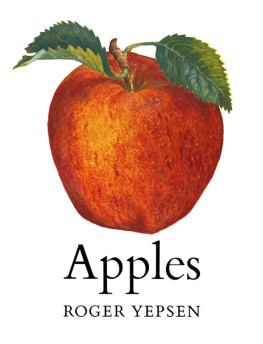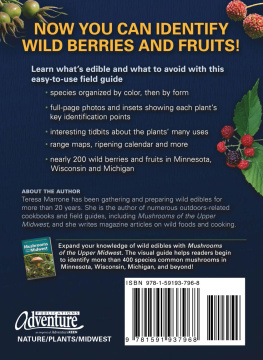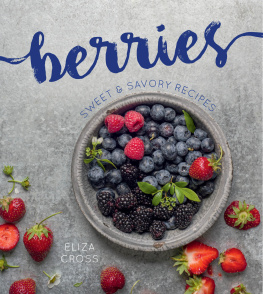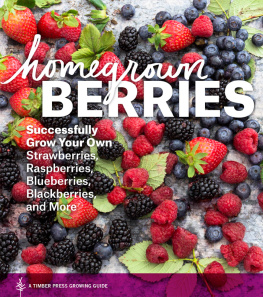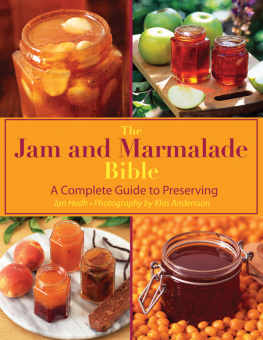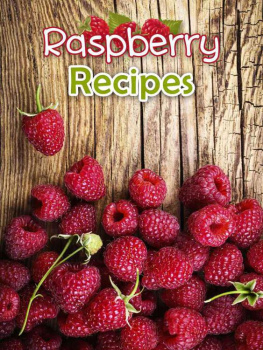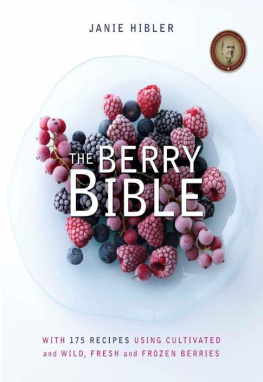

Remembering my mother, Natalie, and the blueberries on Lille ;
and looking forward to berry picking with my grandchildren Atlas and Juniper.
CONTENTS




BLACK RASPBERRY
Berry-pickers, like poets, are born, not made. So wrote Martha Bockee Flint in A Garden of Simples, published in 1900. Maybe so. Some people will take a walk in the countryside and be oblivious to the berries, while others stand rooted by each shrub, purple-;handed, until it has been completely stripped of fruit.
And yet a summer of berry picking can change your sensibilities, because you have to be keenly alive to your surroundings in order to find the berries (and avoid their thorns). It would be interesting to query a sample of environmentalists and naturalists and ask if their choice of profession was influenced by picking berries as children. Americas first environmental radical, Henry David Thoreau, noted that wild blueberries were valuable not only as a food but also as an introduction to the joys of the natural world for the New England children who picked them as a family chore.
Berries have this potential power because they are edible jewels, compounded of sunlight and soil and floral perfume. Their colors are so pure and saturated that we call on berry names when defining a range of hues from warm pinks to chilly purples. Berry flavors and aromas are concentrated, too. While some offer an ambrosial sweetness, others are as assertive and individualistic as spices. Strawberries come across candylike and child-pleasing; at the darker end of the berry spectrum, black currants put off a murky reek that bewitches some people and repels others. Because berries have such distinctive flavors and scents, grape wines often are described in berry terms. Read the back label on a big red vintage and you may find a highly imaginative blurb claiming the wine is redolent of black currant jam or ripe elderberriesa curious convention, in that relatively few Americans are familiar with either.
This book is a guide to getting more involved with berries, including neglected ones that have all but disappeared from the American diet and garden. Berries can be used any time of day, in any meal or type of dish. It may be impossible to improve on the taste of fresh-picked berries, but youll find recipes that suggest ways of taking advantage of their color, flavor, and recently confirmed nutritional benefits. These ideas range from cobblers to cocktails, from Black Currant Corn Pancakes in the morning (see page 78) to a glass of homemade Tutti Frutti Liqueur before retiring at night (page 54). Along with familiar tarts and pies, the recipes include such quaint treats such as a buckle, a grunt, a slump, and a fool.
One reason we arent on more intimate terms with berries is that they can be perversely fragile. Most dont take well to large-scale agriculture and long-haul shipping. Some, such as the yellow raspberry and salmonberry, are almost impossible to transport or store. More than 40 percent of certain fresh berries are lost between harvesting and reaching the consumers table, which helps to explain their high cost.
BERRIES AS A STAPLE
Across much of the cooler reaches of the Northern Hemisphere, berries once were a basic part of the diet, whether eaten fresh or processed into jams, juices, and alcoholic beverages. Back before the ready availability of citrus fruits, berries provided a crucial source of vitamin C. Native Americans may have liked the taste of strawberries baked in their cornbread (see Pan-Fried Strawberry Polenta, page 185), but the berries were there out of nutritional necessity, not simply as a novel twist on a timeworn recipe. The Senecas developed a combination berry pickers basket and evaporating tray, which held the just-picked berries and also provided a latticework on which the fruits were preserved by drying. Although berries were an important part of the Native American diet, the women and children who did the picking didnt seem to treat the job as onerous. According to period accounts, this was a social event, with much singing as they worked.
As the Europeans settled throughout berry country, children continued to be responsible for much of the harvest. Somewhat uncharacteristically for a man who thrived on solitude, Thoreau mentioned feeling lonely on his daily hikes after the blueberry season had ended and the young people with their buckets were gone from the countryside.
Over time, the berry pickers were more likely to be out in the fields to earn money than to supply their familys needs. Thoreau bemoaned the change, calling it a desecration to convert wild blueberries to cash; the tiny fruits had become enslaved by capitalism. With this shift, landowners began nailing up no-trespassing signs around their best berry fields, something new in the American landscape. Nature is under a veil there, Thoreau wrote of the posted acreage. Meanwhile, farming practices were depleting the soil. No longer were entire hills tinted red by wild berries, as the first European settlers had noted. By the late nineteenth century, observers of the landscape were grumbling nostalgically about the berry harvests of the past.
Still, gathering berries has remained a way of life across much of rural North America. People continue to anticipate each flush of berries, from the first strawberries of early summer to the last diehard raspberries of fall. Other activities are postponed as these berry lovers scout the best patches while the fruit still is unripe, then head out with their favorite collecting containers for long, patient hours of foraging. By doing so, they are taking an intimate part in a traditional way of gathering food; there is no better way to step into this continents pre-Columbian history than to spend an hour picking berries. In a pinch, knowing where to find the berries can save a life. A 1934 newspaper account told how a Nova Scotia woman, lost in the wilds for nine days, was able to survive on the blueberries and raspberries she found. When rescued, she was six pounds lighter but in good health.
Berry lovers are protective of their prized patches. My parents discovered an extensive blueberry thicket along an old logging road within a two-mile walk of their Adirondack summer home. The berries went into pies that they shared with neighbors. And the neighbors, reasonably enough, began asking where all the berries came from. We could tell you, but then wed have to kill you, was my parents standard line. To escape notice, they took to wearing binoculars as a subterfuge while picking. Whenever a car or truck approached, they hid their cups of berries and pretended to be eying a warbler.
In Montana, huckleberries enjoy the same devotion as blueberries do in the Northeast. Ellen Bryson can locate patches of the ripe berries just by catching their scent while driving through the countryside with her husband at the wheel. When she catches a whiff, she yells to her husband to stop. If the people in a following vehicle wonder whats going on, Ellens license plate gives a clue: it reads hklbry .
Next page

